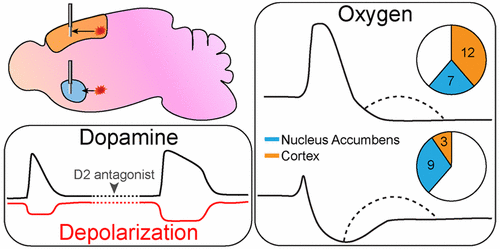当前位置:
X-MOL 学术
›
ACS Chem. Neurosci.
›
论文详情
Our official English website, www.x-mol.net, welcomes your feedback! (Note: you will need to create a separate account there.)
Comparison of Spreading Depolarizations in the Motor Cortex and Nucleus Accumbens: Similar Patterns of Oxygen Responses and the Role of Dopamine
ACS Chemical Neuroscience ( IF 5 ) Pub Date : 2017-09-05 00:00:00 , DOI: 10.1021/acschemneuro.7b00266 Caddy N. Hobbs 1 , Gordon Holzberg 1 , Akira S. Min 1 , R. Mark Wightman 1, 2
ACS Chemical Neuroscience ( IF 5 ) Pub Date : 2017-09-05 00:00:00 , DOI: 10.1021/acschemneuro.7b00266 Caddy N. Hobbs 1 , Gordon Holzberg 1 , Akira S. Min 1 , R. Mark Wightman 1, 2
Affiliation

|
Spreading depolarizations (SD) are pathophysiological phenomena that spontaneously arise in traumatized neural tissue and can promote cellular death. Most investigations of SD are performed in the cortex, a brain region that is susceptible to these depolarizing waves and accessible via a variety of monitoring techniques. Here, we describe SD responses in the cortex and the deep brain region of the nucleus accumbens (NAc) of the anesthetized rat with a minimally invasive, implantable sensor. With high temporal resolution, we characterize the time course of oxygen responses to SD in relation to the electrophysiological depolarization signal. The predominant oxygen pattern consists of four phases: (1) a small initial decrease, (2) a large increase during the SD, (3) a delayed increase, and (4) a persistent decrease from baseline after the SD. Oxygen decreases during SD were also recorded. The latter response occurred more often in the NAc than the cortex (56% vs 20% of locations, respectively), which correlates to denser cortical vascularization. We also find that SDs travel more quickly in the cortex than NAc, likely affected by regional differences in cell type populations. Finally, we investigate the previously uncharacterized effects of dopamine release during SD in the NAc with dopamine receptor blockade. Our results support an inhibitory role of the D2 receptor on SD. As such, the data presented here expands the current understanding of within- and between-region variance in responses to SD.
中文翻译:

运动皮层和伏隔核中扩展去极化的比较:相似的模式的氧气反应和多巴胺的作用。
扩展去极化(SD)是在受创的神经组织中自发出现的病理生理现象,可促进细胞死亡。SD的大多数研究都是在大脑皮层中进行的,大脑皮层容易受到这些去极化波的影响,可以通过多种监测技术进行访问。在这里,我们描述了使用微创植入式传感器的麻醉大鼠伏隔核(NAc)的皮质和深脑区域的SD反应。具有高时间分辨率,我们表征了相对于电生理去极化信号的氧气对SD的响应的时程。主要的氧气模式由四个阶段组成:(1)初期的小幅下降,(2)SD期间的大幅上升,(3)延迟的上升,以及(4)SD后从基线持续下降。还记录了SD期间的氧气减少。后者的反应发生在NAc中的频率要高于皮质(分别是位置的56%和20%),这与更密集的皮质血管形成有关。我们还发现,SDs在皮质中的移动速度比NAc更快,这可能受细胞类型种群区域差异的影响。最后,我们研究了在多巴胺受体阻滞的NAc中SD期间多巴胺释放的先前未表征的作用。我们的结果支持D2受体对SD的抑制作用。这样,此处提供的数据扩展了对SD响应中区域内和区域间方差的当前理解。这与更密集的皮质血管形成有关。我们还发现,SDs在皮质中的移动速度比NAc更快,这可能受细胞类型种群区域差异的影响。最后,我们研究了在多巴胺受体阻滞的NAc中SD期间多巴胺释放的先前未表征的作用。我们的结果支持D2受体对SD的抑制作用。这样,此处提供的数据扩展了对SD响应中区域内和区域间方差的当前理解。这与更密集的皮质血管形成有关。我们还发现,SDs在皮质中的移动速度比NAc更快,这可能受细胞类型种群区域差异的影响。最后,我们调查了在多巴胺受体阻滞的NAc中SD期间多巴胺释放的先前未表征的作用。我们的结果支持D2受体对SD的抑制作用。这样,此处提供的数据扩展了对SD响应中区域内和区域间方差的当前理解。
更新日期:2017-09-06
中文翻译:

运动皮层和伏隔核中扩展去极化的比较:相似的模式的氧气反应和多巴胺的作用。
扩展去极化(SD)是在受创的神经组织中自发出现的病理生理现象,可促进细胞死亡。SD的大多数研究都是在大脑皮层中进行的,大脑皮层容易受到这些去极化波的影响,可以通过多种监测技术进行访问。在这里,我们描述了使用微创植入式传感器的麻醉大鼠伏隔核(NAc)的皮质和深脑区域的SD反应。具有高时间分辨率,我们表征了相对于电生理去极化信号的氧气对SD的响应的时程。主要的氧气模式由四个阶段组成:(1)初期的小幅下降,(2)SD期间的大幅上升,(3)延迟的上升,以及(4)SD后从基线持续下降。还记录了SD期间的氧气减少。后者的反应发生在NAc中的频率要高于皮质(分别是位置的56%和20%),这与更密集的皮质血管形成有关。我们还发现,SDs在皮质中的移动速度比NAc更快,这可能受细胞类型种群区域差异的影响。最后,我们研究了在多巴胺受体阻滞的NAc中SD期间多巴胺释放的先前未表征的作用。我们的结果支持D2受体对SD的抑制作用。这样,此处提供的数据扩展了对SD响应中区域内和区域间方差的当前理解。这与更密集的皮质血管形成有关。我们还发现,SDs在皮质中的移动速度比NAc更快,这可能受细胞类型种群区域差异的影响。最后,我们研究了在多巴胺受体阻滞的NAc中SD期间多巴胺释放的先前未表征的作用。我们的结果支持D2受体对SD的抑制作用。这样,此处提供的数据扩展了对SD响应中区域内和区域间方差的当前理解。这与更密集的皮质血管形成有关。我们还发现,SDs在皮质中的移动速度比NAc更快,这可能受细胞类型种群区域差异的影响。最后,我们调查了在多巴胺受体阻滞的NAc中SD期间多巴胺释放的先前未表征的作用。我们的结果支持D2受体对SD的抑制作用。这样,此处提供的数据扩展了对SD响应中区域内和区域间方差的当前理解。



























 京公网安备 11010802027423号
京公网安备 11010802027423号